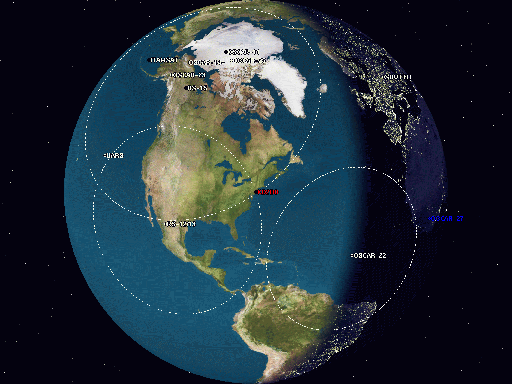
Introduction to the project
ISS Transit email-alert signup page
Project Goals & Stuff ToDo
Released Software
SourceForge project page
Links:
Browsable Source Code
Sun & Moon Tracking
My Java program for computing the position of the sun: thomasfly.com/Sunrise
Mark Huss' Java AstroLib, which is ultimately based upon Jean Meeus' book.
Earth mapping
NASA satellite-derived imagery
John Walker's Earth Screen Saver, which uses the above NASA imagery
the more general Home Planet software
the Xearth source code includes mapdata.cpp, which represents land & ocean areas using 3D point data (at approximately 20-mile intervals)
Physical Map of the World ( 2.7 MB PDF format )
Satellite Tracking / Two-line Elements
The skinny on Two-Line Element Set Format: ghrc.msfc.nasa.gov/orbit/tleformat.html
the complete low-down on 2-line elements, including Fortran code: celestrak.com/NORAD/documentation/spacetrk.pdf
sgp4-plb26a.zip contains T.S. Kelso's Pascal implementation of the above: celestrak.com/software/tskelso-sw.shtml
NORAD Two-Line Element sets: celestrak.com/NORAD/elements
Daily Two-Line Element sets for the ISS: spaceflight.nasa.gov/realdata/sightings/SSapplications/Post/JavaSSOP/orbit/ISS/SVPOST.html
Frequently Asked Questions: Two-Line Element Set Format: celestrak.com/columns/v04n03
more Frequently Asked Questions: celestrak.com/columns/v04n05
Index of T.S. Kelso's articles on Computers & Satellites: celestrak.com/columns
NASA's short explanation: spaceflight.nasa.gov/realdata/elements
supplemental diagram: spaceflight.nasa.gov/realdata/elements/graphs.html
John Magliacane's satellite tracking software for Linux: www.qsl.net/kd2bd/predict.html
of particular note are the graphics at the end of that page, such as:
Mike McCants' QuickSat program: users2.ev1.net/~mmccants
SatPasses: bester.com/satpasses.htm
Assorted "Satellite Prediction Software": satobs.org/orbsoft.html
and even more: amsat.org/amsat/ftpsoft.html
Reference
Yale Bright Star Catalog: ftp://dbc.nao.ac.jp/DBC/NASAADC/catalogs/5/5050
Abbreviated Yale catalog: http://web.mit.edu/afs/athena/project/xephem/src/xephem-3.4/GUI/xephem/catalogs
Related cool stuff
Alphonse Pouplier's PC-controlled tripod users.skynet.be/alphonse/tripod.htm:
Books:
Astronomical Algorithms, 2nd Edition by Jean H. Meeus
Hardcover: 477 pages
Astronomical Algorithms by Jean H. Meeus
Hardcover: 429 pages
Practical Astronomy with your Calculator by Peter Duffett-Smith
Paperback: 185 pages
SourceForge Info:
Getting started with SourceForge
SourceForge.net: Project Documentation
Software Tools:
SourceForge doesn't make FTP available for uploading files (such as this web page). Instead, you use "secure copy" protocol, SCP. Martin Přikryl's WinSCP is free, and it works great.
My present workstation runs Windows XP Pro; I use Borland JBuilder for Java development.
For Java code editing, I normally use JBuilder's built-in editor, in CUA mode. However, outside of JBuilder (looking at T.S. Kelso's Pascal SGP4 code, for example), I usually use Emacs. Alt-x activates the "mini-buffer" at the bottom of the screen. You can then type "shell" (followed by Enter), and it gives you a much nicer "command window" than the standard Windows command window (in particular, you have all of Emacs editing functions available to you)- in the Linux world, this facility gives you a nicer "terminal" than the standard terminal program, for exactly the same reasons.
The Windows search function is brain damaged. Search+Replace is an indispensable utility that lets you do regular-expression searches & replaces.
ZipScan will let you quickly root out Java classes hidden away in jar files, somewhere on your system. In the process, it can help you resolve classpath & versioning problems.
FolderMatch is a nice utility for comparing directories and files, and synchronizing directories. I have Samba set up on my Linux web server, which lets FolderMatch synchronize Linux directories with Windows directories over my LAN.
WinMerge is a great utility for comparing files, and optionally merging (selected) differences between them, and... it's freely available on SourceForge!
SnagIt is an indispensable utility which, for the most part, I use for screen (or parts thereof) captures. It can save the output image in any of the standard formats (gif, png, bmp, jpeg, etc.).
MacroExpress, while rarely directly useful for code development, is nonetheless one of the most generally useful programs I own. It effectively implements its own programming language, rather like Unix shell programming, but it also can move the mouse around, and click on things for you, waiting until web pages to load before doing so, etc., etc.
I use Adobe PhotoShop Elements, which came with my Epson Perfection 1650 Photo scanner, for image editing. This program is an inexpensive, but powerful, little brother of Adobe PhotoShop.
If you didn't already know, Java Archive (jar) files are just zip files, so you can use WinZip to fiddle with them.
DJ Java Decompiler "Good artists copy, great artists steal." -Pablo Picasso
When I go to a web page that contains an applet, the applet ends up getting cached in C:\Documents and Settings\Thomas Fly\.jpi_cache\jar\1.0 (of course, you can always look at the web page's HTML source, to determine the URL of the applet code, anyway). 'Nuff said, hehe...
I used Java2HTML to convert my Java source files to HTML ("Browsable Source Code").
updated 28 Jan 2003